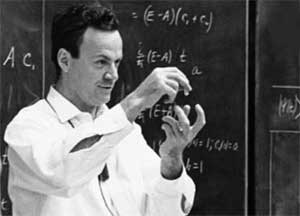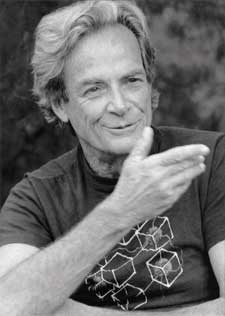Richard Feynman
- Birthdate
- 1918/05/11
- Birthplace
- Queens, NY, USA
- Death date
- 1988/02/15
- Associated organizations
- Los Alamos, Princeton University
- Fields of study
- Nanotechnology
- Awards
- Nobel Prize in Physics
Biography
Born on 11 May 1918 in Queens, New York, Richard Feynman was the first child of Melville and Lucille Feynman. Melville, the son of immigrants, had dreamed of a career in science himself, but would only realize that dream through his son whose early talent for math and science he encouraged.
Feynman considered a career as a mathematician, but soon discovered a passion for physics. He completed his undergraduate studies at the Massachusetts Institute of Technology (MIT) in 1939, and his graduate studies at Princeton University, where he obtained his Ph.D. in 1942. During his time at school, he met the woman he would marry, Arline Greenbaum. The two became inseparable and planned to marry once Feynman earned his Ph.D. Unfortunately, Arline was diagnosed with tuberculosis, and though advised against it by family and colleagues, Feynman married Arline before completing his degree to better tend to her needs.
Feynman earned respect among his peers at Princeton, who encouraged him to join the group of scientists working on the Manhattan Project, a project dedicated to developing the first nuclear weapon, in Los Alamos, New Mexico. Feynman accepted the offer and moved Arline to an Albuquerque hospital, where he could see her in his down time. In 1945, shortly before the first tests of the bomb, Arline succumbed to her illness. Feynman immersed himself in his work, until the project was complete. An offer from the Institute for Advanced Study at Princeton revitalized Feynman, who was in low spirits following his wife’s death. It prompted him to return to ideas he had explored in his Ph.D. thesis; one that focused on computing the probability of a transition from one quantum state to another. Feynman developed diagrams that illustrated the mathematical expressions necessary to describe the behavior of systems of interacting particles. These diagrams have since become a standard theoretical tool and bear his name. It was for this work that Feynman received the Nobel Prize in Physics in 1965. Feynman's influence is also felt in the emergent field of nanotechnology. In a 1959 lecture entitled “There's Plenty of Room at the Bottom,” Feynman discussed a future that included micromachines and constructing things on the atomic level. Physicist K. Eric Drexler, a pioneer in nanotech, was, in part, inspired by Feynman’s work.
During the 1950s, Feynman had a short-lived marriage, and in the early 1960s he married Gweneth Howarth, the woman who would see him to the end of his days. They had one son, Carl, and later adopted a daughter, Michelle. During this time, he worked as a professor at the California Institute of Technology (Caltech), where he rewrote the Freshman Physics curriculum—a collection of lectures still popular today. He would hold the position until his death.
In 1986, Feynman worked with fellow scientists investigating the explosion of the Challenger space shuttle. It was Feynman who discovered that the rubber O-rings were the culprit in the tragedy. Wanting to guarantee that this information would not be buried in the politics surrounding the case, he announced his discovery during a live, televised commission meeting, shattering any chance of a cover-up.
In all of his years as student and teacher, Feynman had become a talented storyteller, weaving in tales of his own adventures. Eventually these were to be compiled and published in 1985 under the title Surely You’re Joking, Mr. Feynman. It became a bestseller, and remained on the bestseller list for a number of weeks. After his death, a second collection of his stories was published, What Do You Care What Other People Think?, which also sold very well.
By 1987, a recurrent bout with cancer was clearly weakening Feynman. He chose to forego any attempts to prolong his life, passing away on 15 February 1988.
Feynman was a member of the American Physical Society, the American Association for the Advancement of Science, the National Academy of Science, and in 1965, he was elected a foreign member of the Royal Society, London. In addition to the Nobel Prize, he received many other honors, including the Albert Einstein Award from Princeton University, the Albert Einstein Award from the College of Medicine, and the Lawrence Award.
Further Reading
Richard Feynman and Micromachines

